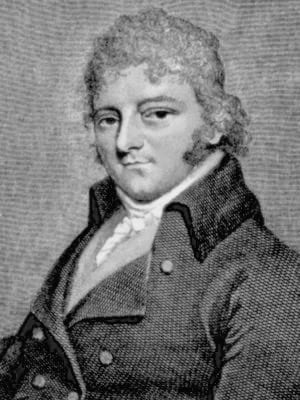Caleb Hillier Parry
Caleb Hillier Parry (1755 – 1822) was an English physician.
Parry is best remembered for his accurate description of the pathophysiology of ischaemic heart disease. He was the first to establish a relationship between angina and coronary heart disease, and that the functional efficiency of the coronary arteries was more indicative than their structural integrity. He described the concept that ischaemic heart disease resulted from energy demands of the myocardium, which the vascular system was unable to supply.
After a stroke in 1816 Parry was unable to continue with his medical practice. Despite his disability, his intellect was unimpaired, and with the assistance of his dutiful daughter, he accumulated a collection of his writings and observations. They include include accounts of progressive hemifacial atrophy (Parry-Romberg syndrome – 1846); congenital idiopathic dilatation of the colon (Hirschprung disease – 1886) and expophthalmic goitre (Graves disease – 1935). The writings were published three years after his death by his eldest son, the physician Charles henry Parry.
Biography
- Born 21 October 1755 Cirencester, England
- Cirencester Grammar School with Edward Jenner
- 1771 – Dissenters’ Academy, Warrington (Not Church of England, so unable to have Oxbridge education)
- 1778 – Medical doctorate, Edinburgh University
- 1779 – General Practitioner; physician to the Puerperal Charity Hospital and Casualty Hospital, Bath
- 1816 – Suffered a stroke in 1816 which left him with aphasia and right hemiplegia. With the assistance of his daughter, Parry edited his notes, cases and observations using his left hand to annotate.
- Died 9 March 1822
Medical Eponyms
Parry-Romberg syndrome (1825, 1846) (Romberg syndrome)
Parry wrote an account of the condition now known as progressive hemifacial atrophy.
Miss F., aged twenty-eight, tall, thin, and with a somewhat florid complexion, thirteen or fourteen years ago, when at school, was rather suddenly seized with some degree of hemiplegia of the left side, accompanied with transient confusion of intellects. The exact state of the original symptoms it is now impossible to ascertain. It is certain, however, that she has at various times been affected with headaches, and that from the period of the attack the left side of the face began to grow more thin than the right, and the eye to become less prominent, and therefore to appearance smaller.,,when she protrudes her tongue, it turns to the left ; but there is no dropping of the eyelids, or corner of the mouth, nor any weakness or numbness of the limbs on the affected side.
Parry 1825; I: 478-480
Parry Disease (according to Sir William Osler…)
Parry described 8 cases of exophthalmic goitre, predating the classical accounts of Graves (1835) and Basedow (1840). Sir William Osler suggested the manifestations of hyperthyroidism, goitre and exophthalmos be named Parry’s disease [Parry CH, 1825 pp110-128]
The part swelled was the thyroid gland; the eyes were protruded from their sockets, and the countenance exhibited an appearance of agitation and distress, especially on any muscular exertion, which I have rarely seen equalled.
Parry, 1825; II: 112
3. EXOPHTHALMIC GOITRE (Parry’s Disease). Historical Note. In the posthumous writings of Caleb Hillier Parry (1825) is a description of 8 cases of Enlargement of the Thyroid Gland in Connection with Enlargement or Palpitation of the Heart…If the name of any physician is to be associated with the disease, undoubtedly it should be that of Parry, the distinguished old Bath physician.
Osler 1898; 3e: 836-837
Hirschprung disease (1825, 1886)
Parry described a case of idiopathic dilatation of the colon in a male adult with chronic digestive disturbances – a ‘Singular and fatal accumulation of faeces (1804)’. Autopsy revealed an enormously distended colon with no evidence of obstruction in the alimentary canal [Parry CH, 1825; II: 380-386]. This description preceded that of Harald Hirschsprung (1830 – 1916) at the Berlin Congress for Children’s Diseases in 1886
Major Publications
- Parry CH. An inquiry into the symptoms and causes of the syncope anginosa, commonly called angina pectoris : illustrated by dissections. 1799.
- Parry CH. Cases of tetanus, and rabies contagiosa, or canine hydrophobia. London: Underwoods 1814
- Parry CH. Elements of pathology and therapeutics. [Volume I]. London: Underwoods 1815 [ Incomplete Vol II posthumously presented 1825]
- Parry CH. An experimental inquiry into the nature, cause, and varieties of the arterial pulse. London: Underwoods 1816
Following the death of Caleb Hillier Parry aged 66, his son Charles posthumously published his fathers case notes and writings in 1825 including further illuminating insights.
- Parry CH. Collections from the unpublished medical writings of the late Caleb Hillier Parry. Volume I, 1825
- Parry CH. Collections from the unpublished medical writings of the late Caleb Hillier Parry. Volume II, 1825
The most dangerous state incidental to the human mind is a calm acquiescence in the accuracy and extent of its own attainments
Parry CH. 1825
References
- Bibliography. Caleb Hillier Parry (1755 – 1822). World Cat Identities
- Graves S. Congenital idiopathic dilatation of the colon or Hirschprung’s disease. Ann Surg. 1918 Jun; 67(6): 734–737
- Finney JMT. Congenital idiopathic dilatation of the colon. Surg., Gyn. and Obst., igo8, vi, 624.
- Biography: Caleb Hillier Parry Munk’s Roll: Volume II
- Biography: Caleb Hillier Parry. Medical Classics, 1940; 5: 8-30.
- Hull G. Caleb Hillier Parry 1755-1822: a notable provincial physician. J R Soc Med. 1998 Jun; 91(6): 335–338.
- Fye WB. Caleb Hillier Parry. Clin Cardiol. 1992 Aug;15(8):619-21.
- Rolls R. Caleb Hillier Parry (1755-1822). JLL Bulletin: Commentaries on the history of treatment evaluation. 2003
- Larner AJ. Caleb Hillier Parry (1755-1822): clinician, scientist, friend of Edward Jenner (1749-1823). J Med Biogr. 2005; 13(4): 189-94
- Cadogan M. Eponymythology: Diffuse Toxic Goitre. LITFL 2018

